Leadership, Training, and Talent Management: Impact on NHS Performance
VerifiedAdded on 2023/06/18
|8
|2080
|112
Report
AI Summary
This report examines the impact of leadership management, training and development, and talent management on performance management within an organization, focusing on the NHS. It discusses various leadership styles, including democratic leadership and the Great Man Theory, highlighting the importance of skills such as problem-solving and decision-making for leaders. The report emphasizes the role of training and development in improving employee efficiency and overall productivity, referencing the system model of training and development. Furthermore, it explores talent management's role in attracting, selecting, and retaining employees, linking it to performance management through recruitment, training, and employee motivation. The conclusion underscores the crucial role of leadership, training, and talent management in achieving organizational goals.

Mg411 cw1
Paraphrase This Document
Need a fresh take? Get an instant paraphrase of this document with our AI Paraphraser
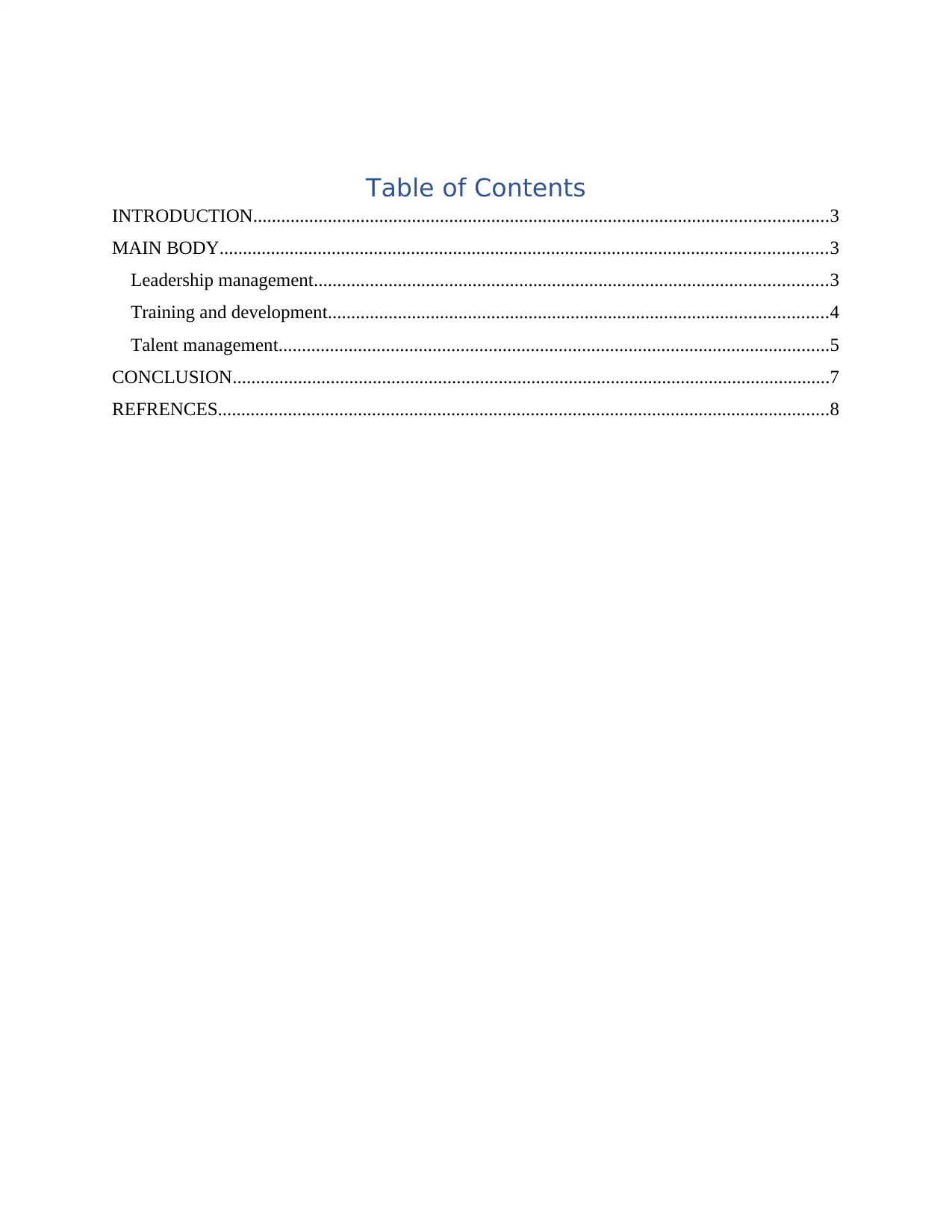
Table of Contents
INTRODUCTION...........................................................................................................................3
MAIN BODY..................................................................................................................................3
Leadership management..............................................................................................................3
Training and development...........................................................................................................4
Talent management......................................................................................................................5
CONCLUSION................................................................................................................................7
REFRENCES...................................................................................................................................8
INTRODUCTION...........................................................................................................................3
MAIN BODY..................................................................................................................................3
Leadership management..............................................................................................................3
Training and development...........................................................................................................4
Talent management......................................................................................................................5
CONCLUSION................................................................................................................................7
REFRENCES...................................................................................................................................8
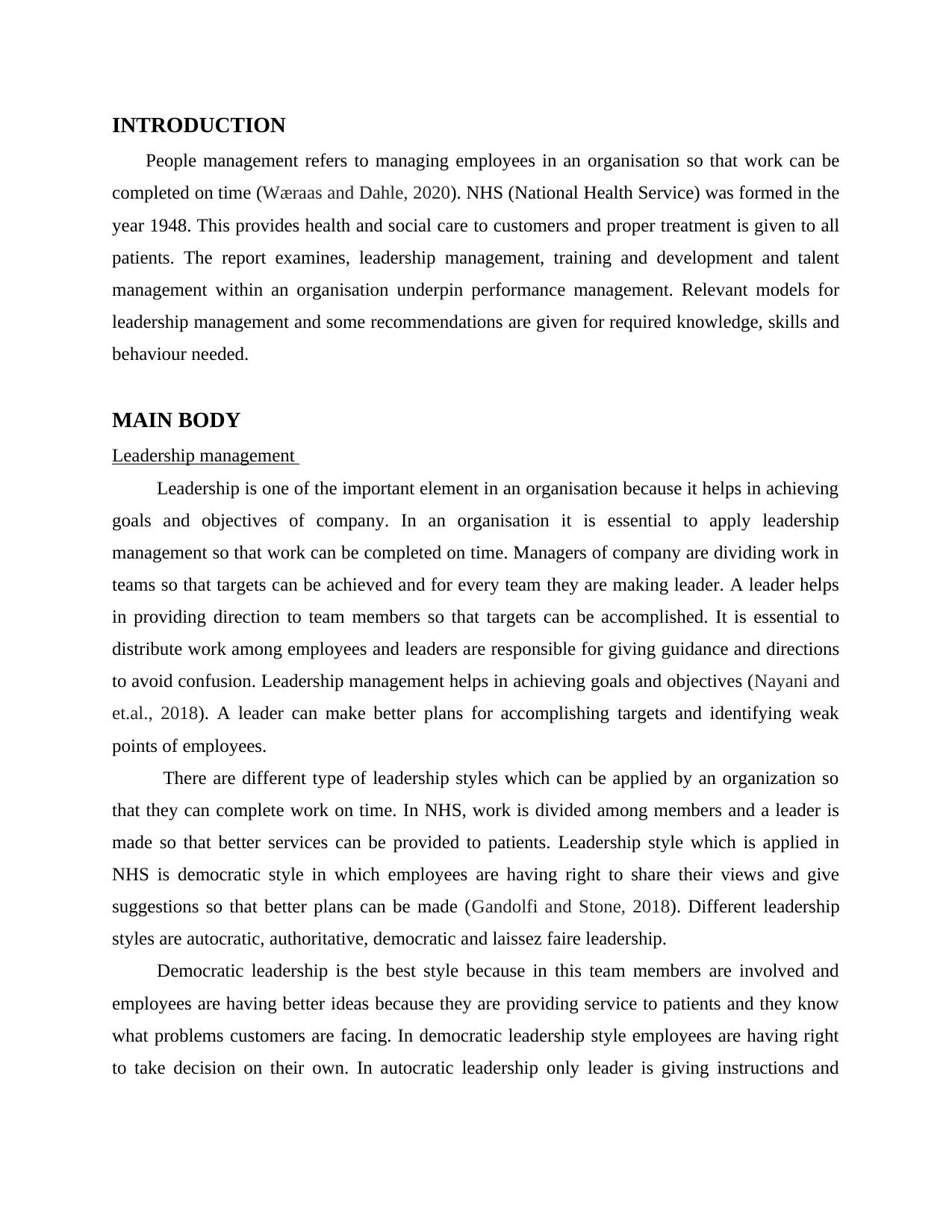
INTRODUCTION
People management refers to managing employees in an organisation so that work can be
completed on time (Wæraas and Dahle, 2020). NHS (National Health Service) was formed in the
year 1948. This provides health and social care to customers and proper treatment is given to all
patients. The report examines, leadership management, training and development and talent
management within an organisation underpin performance management. Relevant models for
leadership management and some recommendations are given for required knowledge, skills and
behaviour needed.
MAIN BODY
Leadership management
Leadership is one of the important element in an organisation because it helps in achieving
goals and objectives of company. In an organisation it is essential to apply leadership
management so that work can be completed on time. Managers of company are dividing work in
teams so that targets can be achieved and for every team they are making leader. A leader helps
in providing direction to team members so that targets can be accomplished. It is essential to
distribute work among employees and leaders are responsible for giving guidance and directions
to avoid confusion. Leadership management helps in achieving goals and objectives (Nayani and
et.al., 2018). A leader can make better plans for accomplishing targets and identifying weak
points of employees.
There are different type of leadership styles which can be applied by an organization so
that they can complete work on time. In NHS, work is divided among members and a leader is
made so that better services can be provided to patients. Leadership style which is applied in
NHS is democratic style in which employees are having right to share their views and give
suggestions so that better plans can be made (Gandolfi and Stone, 2018). Different leadership
styles are autocratic, authoritative, democratic and laissez faire leadership.
Democratic leadership is the best style because in this team members are involved and
employees are having better ideas because they are providing service to patients and they know
what problems customers are facing. In democratic leadership style employees are having right
to take decision on their own. In autocratic leadership only leader is giving instructions and
People management refers to managing employees in an organisation so that work can be
completed on time (Wæraas and Dahle, 2020). NHS (National Health Service) was formed in the
year 1948. This provides health and social care to customers and proper treatment is given to all
patients. The report examines, leadership management, training and development and talent
management within an organisation underpin performance management. Relevant models for
leadership management and some recommendations are given for required knowledge, skills and
behaviour needed.
MAIN BODY
Leadership management
Leadership is one of the important element in an organisation because it helps in achieving
goals and objectives of company. In an organisation it is essential to apply leadership
management so that work can be completed on time. Managers of company are dividing work in
teams so that targets can be achieved and for every team they are making leader. A leader helps
in providing direction to team members so that targets can be accomplished. It is essential to
distribute work among employees and leaders are responsible for giving guidance and directions
to avoid confusion. Leadership management helps in achieving goals and objectives (Nayani and
et.al., 2018). A leader can make better plans for accomplishing targets and identifying weak
points of employees.
There are different type of leadership styles which can be applied by an organization so
that they can complete work on time. In NHS, work is divided among members and a leader is
made so that better services can be provided to patients. Leadership style which is applied in
NHS is democratic style in which employees are having right to share their views and give
suggestions so that better plans can be made (Gandolfi and Stone, 2018). Different leadership
styles are autocratic, authoritative, democratic and laissez faire leadership.
Democratic leadership is the best style because in this team members are involved and
employees are having better ideas because they are providing service to patients and they know
what problems customers are facing. In democratic leadership style employees are having right
to take decision on their own. In autocratic leadership only leader is giving instructions and
⊘ This is a preview!⊘
Do you want full access?
Subscribe today to unlock all pages.

Trusted by 1+ million students worldwide
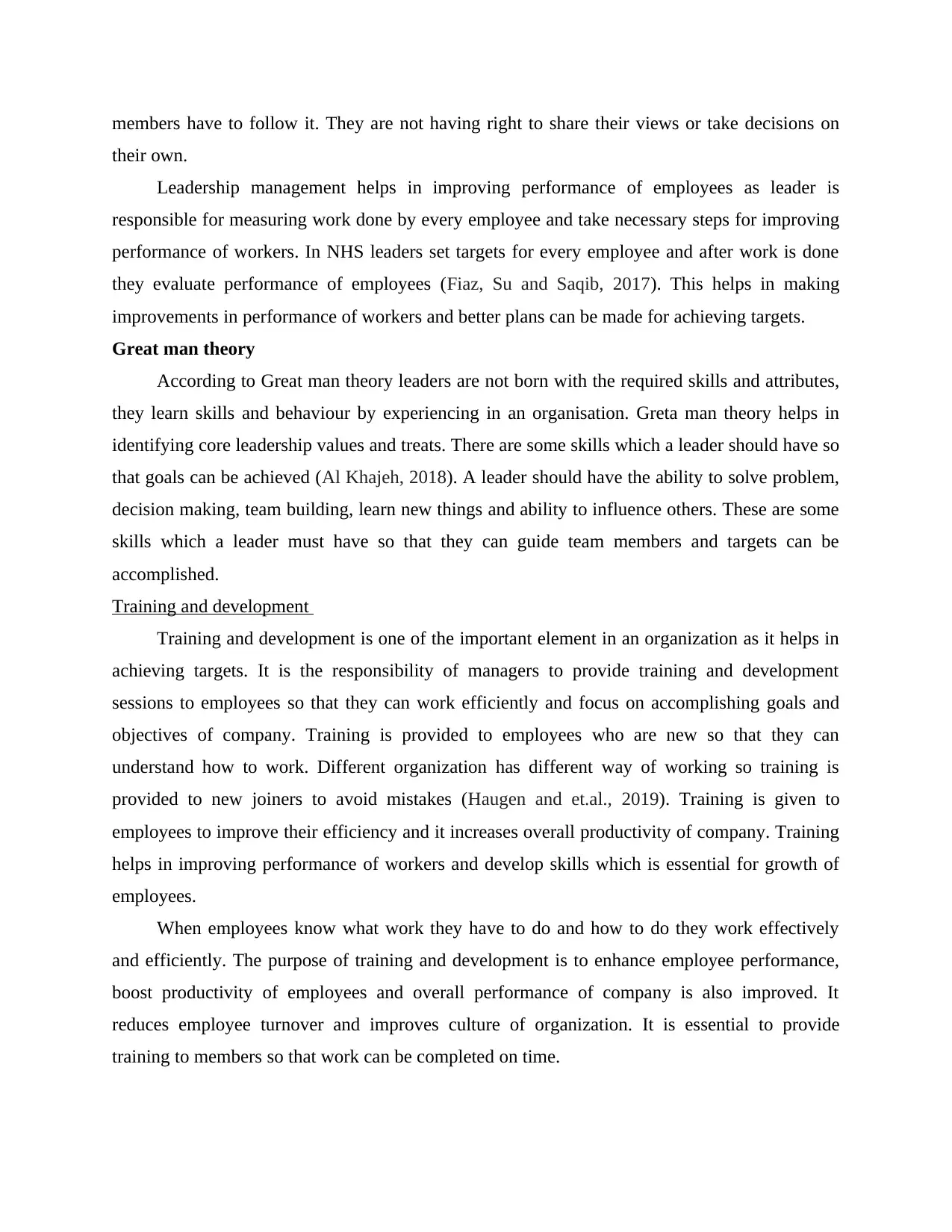
members have to follow it. They are not having right to share their views or take decisions on
their own.
Leadership management helps in improving performance of employees as leader is
responsible for measuring work done by every employee and take necessary steps for improving
performance of workers. In NHS leaders set targets for every employee and after work is done
they evaluate performance of employees (Fiaz, Su and Saqib, 2017). This helps in making
improvements in performance of workers and better plans can be made for achieving targets.
Great man theory
According to Great man theory leaders are not born with the required skills and attributes,
they learn skills and behaviour by experiencing in an organisation. Greta man theory helps in
identifying core leadership values and treats. There are some skills which a leader should have so
that goals can be achieved (Al Khajeh, 2018). A leader should have the ability to solve problem,
decision making, team building, learn new things and ability to influence others. These are some
skills which a leader must have so that they can guide team members and targets can be
accomplished.
Training and development
Training and development is one of the important element in an organization as it helps in
achieving targets. It is the responsibility of managers to provide training and development
sessions to employees so that they can work efficiently and focus on accomplishing goals and
objectives of company. Training is provided to employees who are new so that they can
understand how to work. Different organization has different way of working so training is
provided to new joiners to avoid mistakes (Haugen and et.al., 2019). Training is given to
employees to improve their efficiency and it increases overall productivity of company. Training
helps in improving performance of workers and develop skills which is essential for growth of
employees.
When employees know what work they have to do and how to do they work effectively
and efficiently. The purpose of training and development is to enhance employee performance,
boost productivity of employees and overall performance of company is also improved. It
reduces employee turnover and improves culture of organization. It is essential to provide
training to members so that work can be completed on time.
their own.
Leadership management helps in improving performance of employees as leader is
responsible for measuring work done by every employee and take necessary steps for improving
performance of workers. In NHS leaders set targets for every employee and after work is done
they evaluate performance of employees (Fiaz, Su and Saqib, 2017). This helps in making
improvements in performance of workers and better plans can be made for achieving targets.
Great man theory
According to Great man theory leaders are not born with the required skills and attributes,
they learn skills and behaviour by experiencing in an organisation. Greta man theory helps in
identifying core leadership values and treats. There are some skills which a leader should have so
that goals can be achieved (Al Khajeh, 2018). A leader should have the ability to solve problem,
decision making, team building, learn new things and ability to influence others. These are some
skills which a leader must have so that they can guide team members and targets can be
accomplished.
Training and development
Training and development is one of the important element in an organization as it helps in
achieving targets. It is the responsibility of managers to provide training and development
sessions to employees so that they can work efficiently and focus on accomplishing goals and
objectives of company. Training is provided to employees who are new so that they can
understand how to work. Different organization has different way of working so training is
provided to new joiners to avoid mistakes (Haugen and et.al., 2019). Training is given to
employees to improve their efficiency and it increases overall productivity of company. Training
helps in improving performance of workers and develop skills which is essential for growth of
employees.
When employees know what work they have to do and how to do they work effectively
and efficiently. The purpose of training and development is to enhance employee performance,
boost productivity of employees and overall performance of company is also improved. It
reduces employee turnover and improves culture of organization. It is essential to provide
training to members so that work can be completed on time.
Paraphrase This Document
Need a fresh take? Get an instant paraphrase of this document with our AI Paraphraser
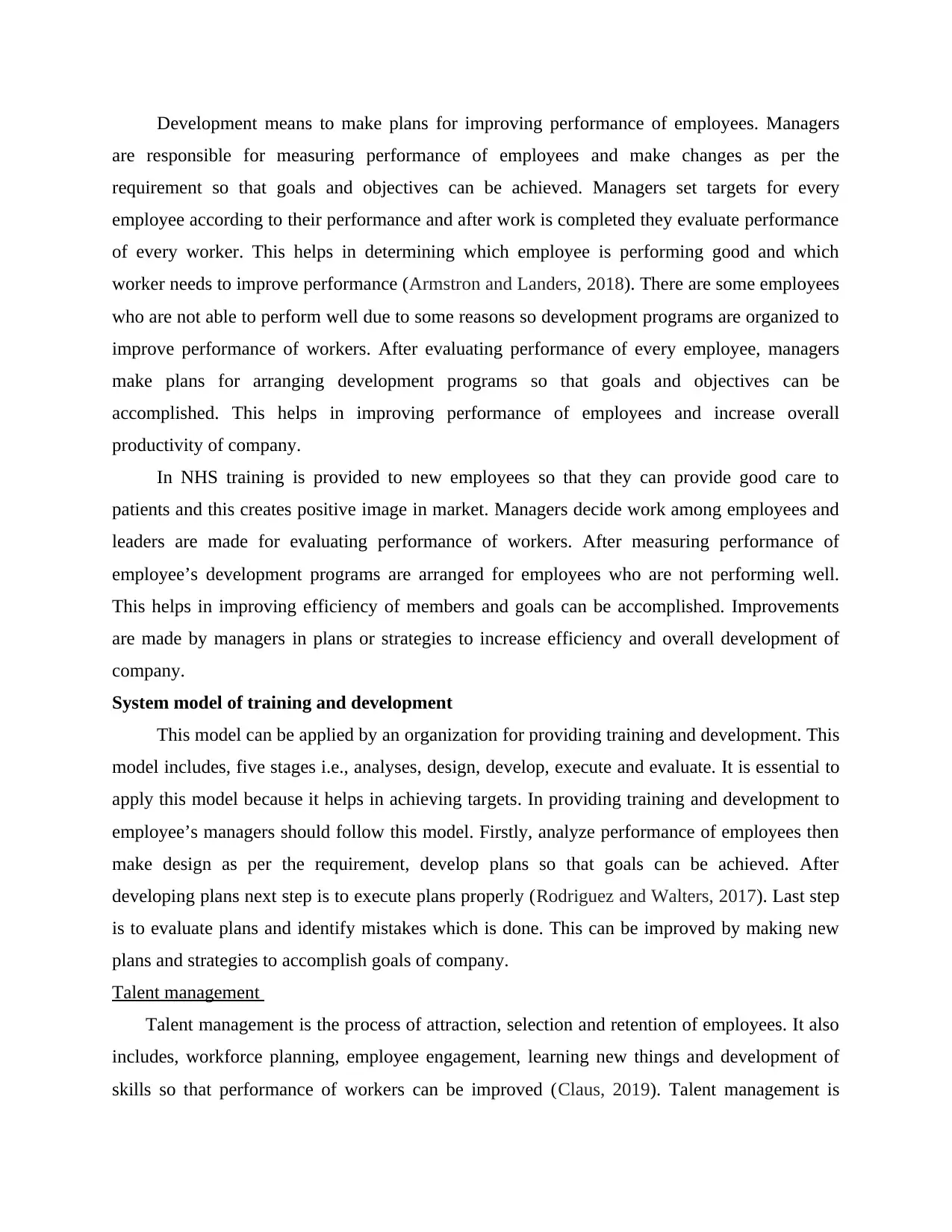
Development means to make plans for improving performance of employees. Managers
are responsible for measuring performance of employees and make changes as per the
requirement so that goals and objectives can be achieved. Managers set targets for every
employee according to their performance and after work is completed they evaluate performance
of every worker. This helps in determining which employee is performing good and which
worker needs to improve performance (Armstron and Landers, 2018). There are some employees
who are not able to perform well due to some reasons so development programs are organized to
improve performance of workers. After evaluating performance of every employee, managers
make plans for arranging development programs so that goals and objectives can be
accomplished. This helps in improving performance of employees and increase overall
productivity of company.
In NHS training is provided to new employees so that they can provide good care to
patients and this creates positive image in market. Managers decide work among employees and
leaders are made for evaluating performance of workers. After measuring performance of
employee’s development programs are arranged for employees who are not performing well.
This helps in improving efficiency of members and goals can be accomplished. Improvements
are made by managers in plans or strategies to increase efficiency and overall development of
company.
System model of training and development
This model can be applied by an organization for providing training and development. This
model includes, five stages i.e., analyses, design, develop, execute and evaluate. It is essential to
apply this model because it helps in achieving targets. In providing training and development to
employee’s managers should follow this model. Firstly, analyze performance of employees then
make design as per the requirement, develop plans so that goals can be achieved. After
developing plans next step is to execute plans properly (Rodriguez and Walters, 2017). Last step
is to evaluate plans and identify mistakes which is done. This can be improved by making new
plans and strategies to accomplish goals of company.
Talent management
Talent management is the process of attraction, selection and retention of employees. It also
includes, workforce planning, employee engagement, learning new things and development of
skills so that performance of workers can be improved (Claus, 2019). Talent management is
are responsible for measuring performance of employees and make changes as per the
requirement so that goals and objectives can be achieved. Managers set targets for every
employee according to their performance and after work is completed they evaluate performance
of every worker. This helps in determining which employee is performing good and which
worker needs to improve performance (Armstron and Landers, 2018). There are some employees
who are not able to perform well due to some reasons so development programs are organized to
improve performance of workers. After evaluating performance of every employee, managers
make plans for arranging development programs so that goals and objectives can be
accomplished. This helps in improving performance of employees and increase overall
productivity of company.
In NHS training is provided to new employees so that they can provide good care to
patients and this creates positive image in market. Managers decide work among employees and
leaders are made for evaluating performance of workers. After measuring performance of
employee’s development programs are arranged for employees who are not performing well.
This helps in improving efficiency of members and goals can be accomplished. Improvements
are made by managers in plans or strategies to increase efficiency and overall development of
company.
System model of training and development
This model can be applied by an organization for providing training and development. This
model includes, five stages i.e., analyses, design, develop, execute and evaluate. It is essential to
apply this model because it helps in achieving targets. In providing training and development to
employee’s managers should follow this model. Firstly, analyze performance of employees then
make design as per the requirement, develop plans so that goals can be achieved. After
developing plans next step is to execute plans properly (Rodriguez and Walters, 2017). Last step
is to evaluate plans and identify mistakes which is done. This can be improved by making new
plans and strategies to accomplish goals of company.
Talent management
Talent management is the process of attraction, selection and retention of employees. It also
includes, workforce planning, employee engagement, learning new things and development of
skills so that performance of workers can be improved (Claus, 2019). Talent management is
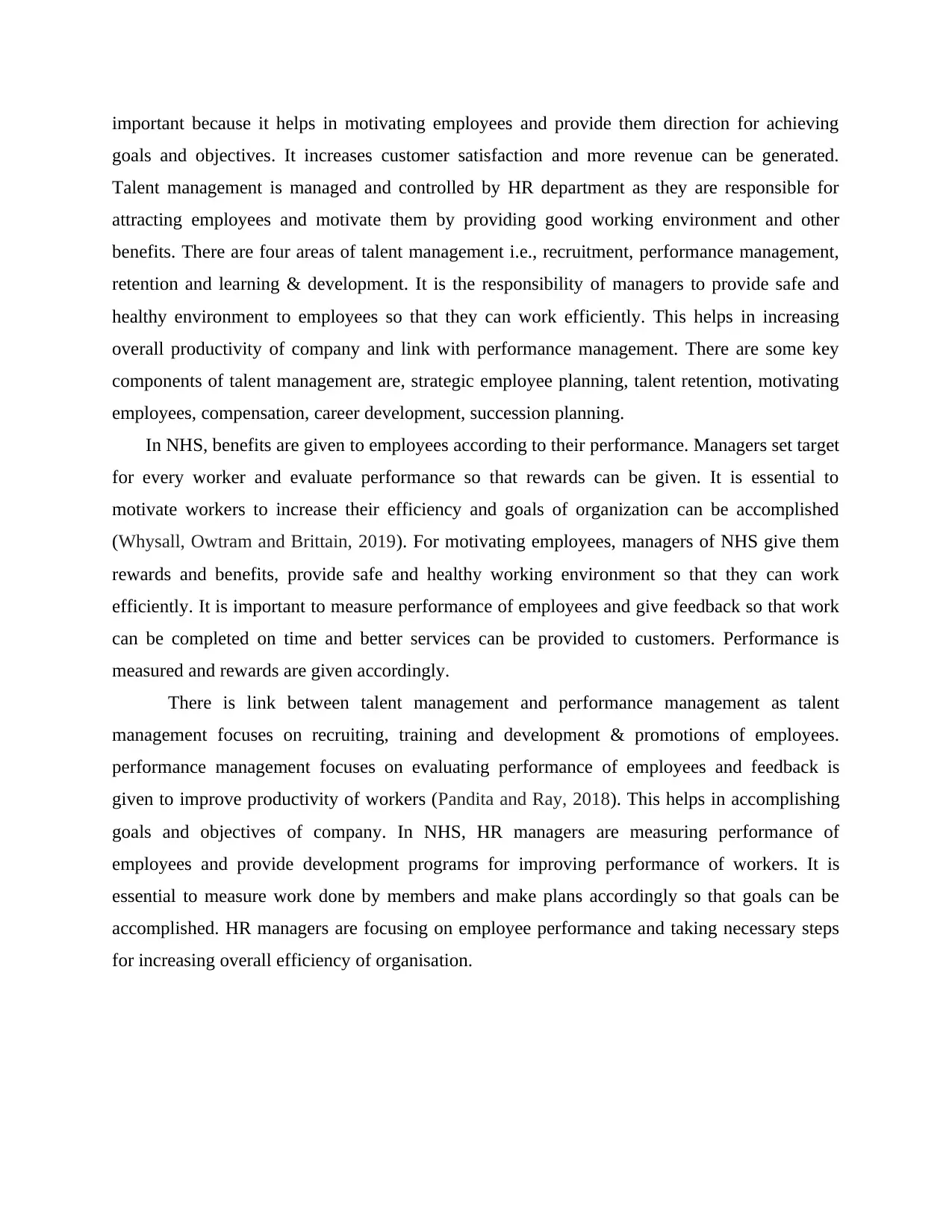
important because it helps in motivating employees and provide them direction for achieving
goals and objectives. It increases customer satisfaction and more revenue can be generated.
Talent management is managed and controlled by HR department as they are responsible for
attracting employees and motivate them by providing good working environment and other
benefits. There are four areas of talent management i.e., recruitment, performance management,
retention and learning & development. It is the responsibility of managers to provide safe and
healthy environment to employees so that they can work efficiently. This helps in increasing
overall productivity of company and link with performance management. There are some key
components of talent management are, strategic employee planning, talent retention, motivating
employees, compensation, career development, succession planning.
In NHS, benefits are given to employees according to their performance. Managers set target
for every worker and evaluate performance so that rewards can be given. It is essential to
motivate workers to increase their efficiency and goals of organization can be accomplished
(Whysall, Owtram and Brittain, 2019). For motivating employees, managers of NHS give them
rewards and benefits, provide safe and healthy working environment so that they can work
efficiently. It is important to measure performance of employees and give feedback so that work
can be completed on time and better services can be provided to customers. Performance is
measured and rewards are given accordingly.
There is link between talent management and performance management as talent
management focuses on recruiting, training and development & promotions of employees.
performance management focuses on evaluating performance of employees and feedback is
given to improve productivity of workers (Pandita and Ray, 2018). This helps in accomplishing
goals and objectives of company. In NHS, HR managers are measuring performance of
employees and provide development programs for improving performance of workers. It is
essential to measure work done by members and make plans accordingly so that goals can be
accomplished. HR managers are focusing on employee performance and taking necessary steps
for increasing overall efficiency of organisation.
goals and objectives. It increases customer satisfaction and more revenue can be generated.
Talent management is managed and controlled by HR department as they are responsible for
attracting employees and motivate them by providing good working environment and other
benefits. There are four areas of talent management i.e., recruitment, performance management,
retention and learning & development. It is the responsibility of managers to provide safe and
healthy environment to employees so that they can work efficiently. This helps in increasing
overall productivity of company and link with performance management. There are some key
components of talent management are, strategic employee planning, talent retention, motivating
employees, compensation, career development, succession planning.
In NHS, benefits are given to employees according to their performance. Managers set target
for every worker and evaluate performance so that rewards can be given. It is essential to
motivate workers to increase their efficiency and goals of organization can be accomplished
(Whysall, Owtram and Brittain, 2019). For motivating employees, managers of NHS give them
rewards and benefits, provide safe and healthy working environment so that they can work
efficiently. It is important to measure performance of employees and give feedback so that work
can be completed on time and better services can be provided to customers. Performance is
measured and rewards are given accordingly.
There is link between talent management and performance management as talent
management focuses on recruiting, training and development & promotions of employees.
performance management focuses on evaluating performance of employees and feedback is
given to improve productivity of workers (Pandita and Ray, 2018). This helps in accomplishing
goals and objectives of company. In NHS, HR managers are measuring performance of
employees and provide development programs for improving performance of workers. It is
essential to measure work done by members and make plans accordingly so that goals can be
accomplished. HR managers are focusing on employee performance and taking necessary steps
for increasing overall efficiency of organisation.
⊘ This is a preview!⊘
Do you want full access?
Subscribe today to unlock all pages.

Trusted by 1+ million students worldwide
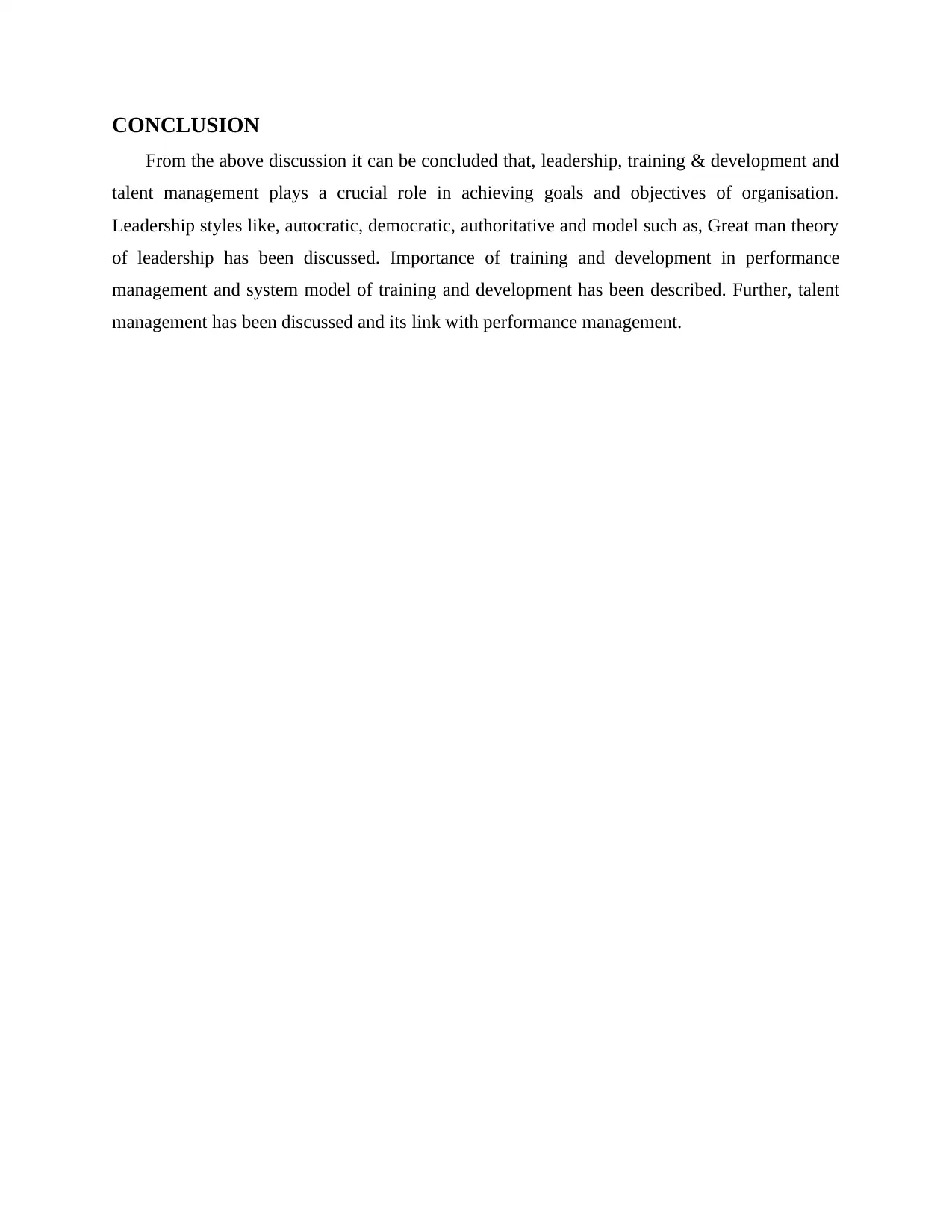
CONCLUSION
From the above discussion it can be concluded that, leadership, training & development and
talent management plays a crucial role in achieving goals and objectives of organisation.
Leadership styles like, autocratic, democratic, authoritative and model such as, Great man theory
of leadership has been discussed. Importance of training and development in performance
management and system model of training and development has been described. Further, talent
management has been discussed and its link with performance management.
From the above discussion it can be concluded that, leadership, training & development and
talent management plays a crucial role in achieving goals and objectives of organisation.
Leadership styles like, autocratic, democratic, authoritative and model such as, Great man theory
of leadership has been discussed. Importance of training and development in performance
management and system model of training and development has been described. Further, talent
management has been discussed and its link with performance management.
Paraphrase This Document
Need a fresh take? Get an instant paraphrase of this document with our AI Paraphraser
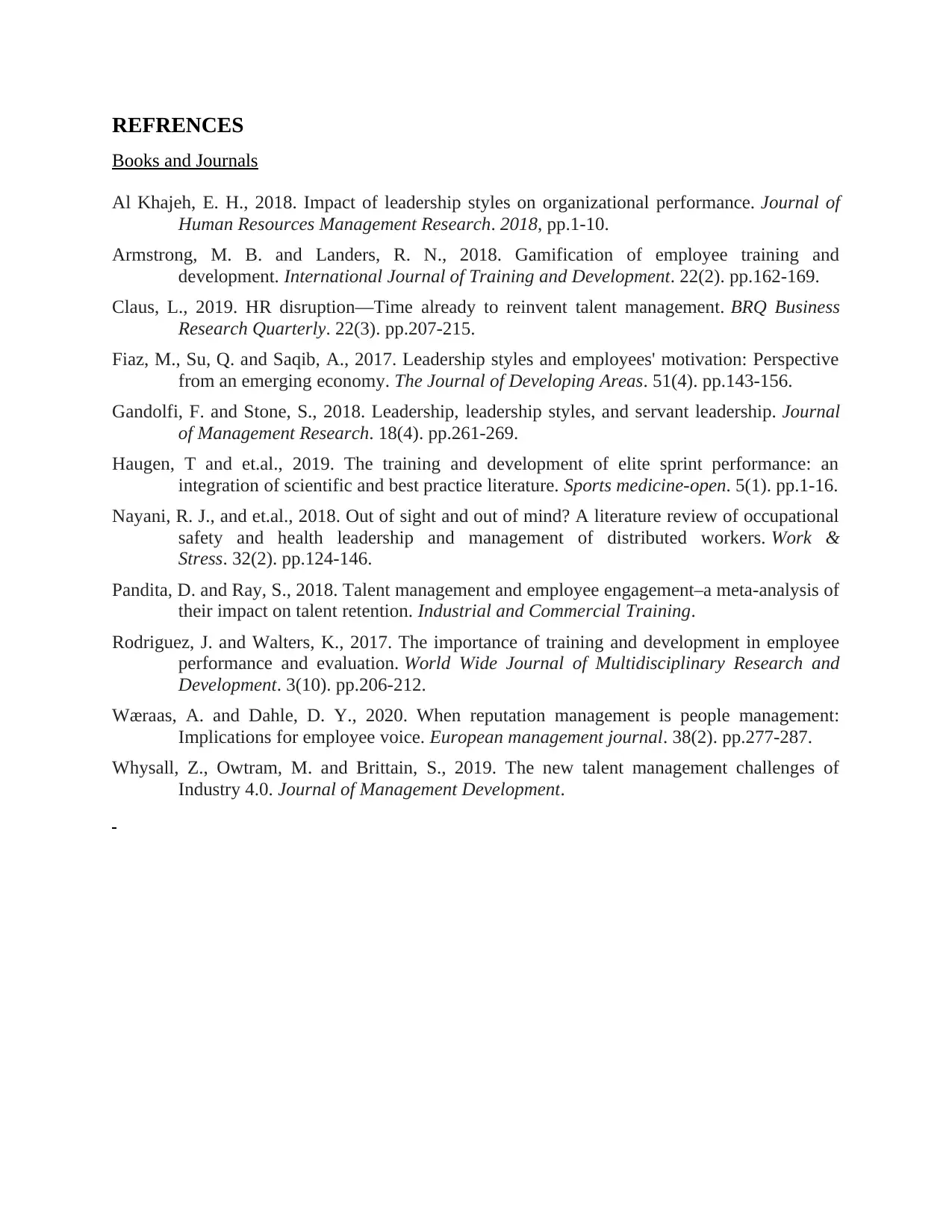
REFRENCES
Books and Journals
Al Khajeh, E. H., 2018. Impact of leadership styles on organizational performance. Journal of
Human Resources Management Research. 2018, pp.1-10.
Armstrong, M. B. and Landers, R. N., 2018. Gamification of employee training and
development. International Journal of Training and Development. 22(2). pp.162-169.
Claus, L., 2019. HR disruption—Time already to reinvent talent management. BRQ Business
Research Quarterly. 22(3). pp.207-215.
Fiaz, M., Su, Q. and Saqib, A., 2017. Leadership styles and employees' motivation: Perspective
from an emerging economy. The Journal of Developing Areas. 51(4). pp.143-156.
Gandolfi, F. and Stone, S., 2018. Leadership, leadership styles, and servant leadership. Journal
of Management Research. 18(4). pp.261-269.
Haugen, T and et.al., 2019. The training and development of elite sprint performance: an
integration of scientific and best practice literature. Sports medicine-open. 5(1). pp.1-16.
Nayani, R. J., and et.al., 2018. Out of sight and out of mind? A literature review of occupational
safety and health leadership and management of distributed workers. Work &
Stress. 32(2). pp.124-146.
Pandita, D. and Ray, S., 2018. Talent management and employee engagement–a meta-analysis of
their impact on talent retention. Industrial and Commercial Training.
Rodriguez, J. and Walters, K., 2017. The importance of training and development in employee
performance and evaluation. World Wide Journal of Multidisciplinary Research and
Development. 3(10). pp.206-212.
Wæraas, A. and Dahle, D. Y., 2020. When reputation management is people management:
Implications for employee voice. European management journal. 38(2). pp.277-287.
Whysall, Z., Owtram, M. and Brittain, S., 2019. The new talent management challenges of
Industry 4.0. Journal of Management Development.
Books and Journals
Al Khajeh, E. H., 2018. Impact of leadership styles on organizational performance. Journal of
Human Resources Management Research. 2018, pp.1-10.
Armstrong, M. B. and Landers, R. N., 2018. Gamification of employee training and
development. International Journal of Training and Development. 22(2). pp.162-169.
Claus, L., 2019. HR disruption—Time already to reinvent talent management. BRQ Business
Research Quarterly. 22(3). pp.207-215.
Fiaz, M., Su, Q. and Saqib, A., 2017. Leadership styles and employees' motivation: Perspective
from an emerging economy. The Journal of Developing Areas. 51(4). pp.143-156.
Gandolfi, F. and Stone, S., 2018. Leadership, leadership styles, and servant leadership. Journal
of Management Research. 18(4). pp.261-269.
Haugen, T and et.al., 2019. The training and development of elite sprint performance: an
integration of scientific and best practice literature. Sports medicine-open. 5(1). pp.1-16.
Nayani, R. J., and et.al., 2018. Out of sight and out of mind? A literature review of occupational
safety and health leadership and management of distributed workers. Work &
Stress. 32(2). pp.124-146.
Pandita, D. and Ray, S., 2018. Talent management and employee engagement–a meta-analysis of
their impact on talent retention. Industrial and Commercial Training.
Rodriguez, J. and Walters, K., 2017. The importance of training and development in employee
performance and evaluation. World Wide Journal of Multidisciplinary Research and
Development. 3(10). pp.206-212.
Wæraas, A. and Dahle, D. Y., 2020. When reputation management is people management:
Implications for employee voice. European management journal. 38(2). pp.277-287.
Whysall, Z., Owtram, M. and Brittain, S., 2019. The new talent management challenges of
Industry 4.0. Journal of Management Development.
1 out of 8
Related Documents
Your All-in-One AI-Powered Toolkit for Academic Success.
+13062052269
info@desklib.com
Available 24*7 on WhatsApp / Email
![[object Object]](/_next/static/media/star-bottom.7253800d.svg)
Unlock your academic potential
Copyright © 2020–2025 A2Z Services. All Rights Reserved. Developed and managed by ZUCOL.





